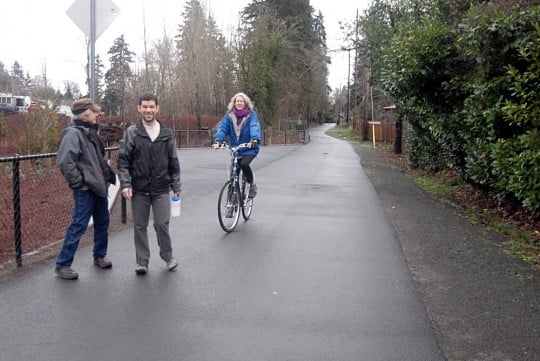
(Photos: M.Andersen/BikePortland)
While Portland prepares to block increased development along parts of TriMet’s newest MAX line, a group of residents further down the Orange Line say they’re welcoming more density with open arms.
Their dream, they say, would be to use three-to-five-story apartment buildings and clusters of new small houses to turn their corner of unincorporated Clackamas County — the last stop on the new MAX line — into a bustling but more nature-rich alternative to Southeast Division Street.
Though they hope to spur changes up and down McLoughlin Boulvard, the key to the plan is a 5.7-acre Elks Club site that sits between McLoughlin and the six-mile Trolley Trail multi-use path that serves as a bike route in the area.
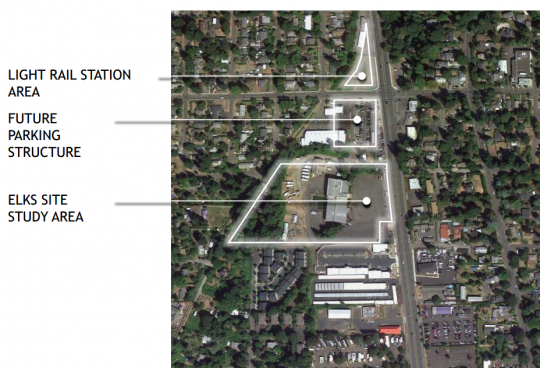
Their proposal: cutting the area’s minimum residential auto parking requirement (it’s currently 1.25 spaces per unit) and allowing up to 60 housing units per acre within a quarter-mile of the SE Park Avenue station. In order to build at that density (or maybe a bit higher), a developer would guarantee to set aside some of the private land for natural areas.
“It seems like it would be a lightning rod that could catch some of the housing Portland is failing to build,” said Joseph Edge, 35, one of the organizers of the effort.
Bringing back commerce

Three members of Oak Grove’s unofficial neighborhood association — members of the McLoughlin Area Plan Implementation Team that’s working to rezone and rethink the area — were hanging out on the Trolley Trail just behind the MAX station as I pedaled up.
Chips Janger stuck out a hand.
“Welcome to our turf,” he said.
Janger, his colleagues say, was the mastermind of a deal that made natural areas part of the design of what will be TriMet’s southernmost MAX stop when it opens in September. Years later, he’s proud to be finally looking over the results: about half an acre of trees, scrubs and grasses in a restored gully between the trail and the new TriMet parking garage.
“This was all used car lots, parking lots, all this stuff,” says Janger, 58. “Our whole purpose is to restore an area that’s been degraded over the last 50 years.”
Advertisement
His colleague Eleanore Hunter, 56, explains that back when the Trolley Trail was an actual electric trolley line — the urban area’s first, she says — Oak Grove was a major destination.
“This was a hoppin’ place to come,” she said. “The jukebox joints, the nightclubs.”
No more. McLoughlin has grown into a busy suburban thoroughfare, but its auto-oriented storefronts are so utilitarian that when this group of neighborhood organizers held their first meeting, they couldn’t think of a single place to gather, sit and talk.
“We ended up at the McMenamins in Oregon City,” Hunter said.
Three reasons developers might choose Oak Grove
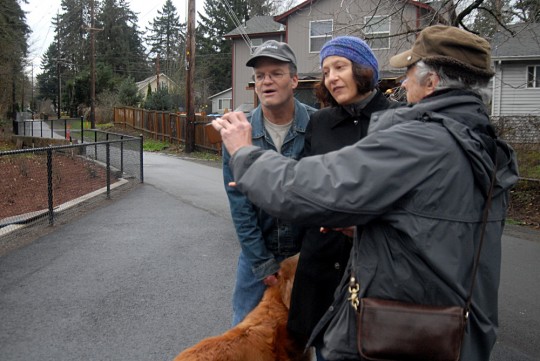
Why would a mixed-use developer make a big bet on the Park Avenue station area? Oak Grove advocates make a few arguments.
First: unlike some Portland neighborhoods, they say it’s eager for change. Zoning laws in the area allow any sort of use.
“With the exception of the density cap on residential zoning, it’s very flexible,” said Edge. “If you didn’t want to get a fight, then you might come here.”
Second: the combination of the Orange Line and Trolley Trail, along with a possible future bike-walking bridge to Lake Oswego, will make it easy to get around without a car in the area.
“We predict that there’s going to be this dramatic shift,” Hunter said. “There are these wonderful small starter homes in these close-knit communities that are within walking distance of the station.”
“We’ve worked real hard to make this a transportation complex,” said Janger. “The Trolley Trail part, the bike part, is as important as the light rail station. We think this is such an important arterial.”
A few of Oak Grove’s oldest homes, in fact, face their front doors directly onto the Trolley Trail. It’s a relic of the time when the area’s most important transportation was the streetcar that once whistled past these front doors and into the city.
And that’s the third reason Janger, Hunter and Edge think it makes sense for their neighborhood to become a suburban hub for low-car life: that’s the sort of lifestyle that built their neighborhood in the first place.
“Oak Grove and the Elks Club were created the last time there was light rail here,” Janger said. “And now we’re back, baby.”
— The Real Estate Beat is a regular column. You can sign up to get an email of Real Estate Beat posts (and nothing else) here, or read past installments here. This sponsorship has opened up and we’re looking for our next partner. If interested, please call Jonathan at (503) 706-8804.



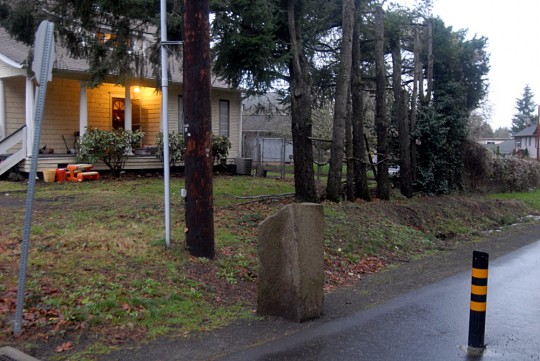
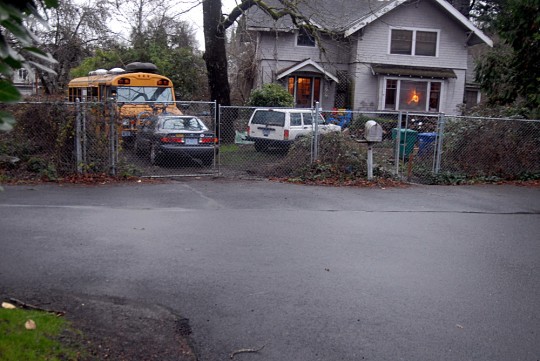
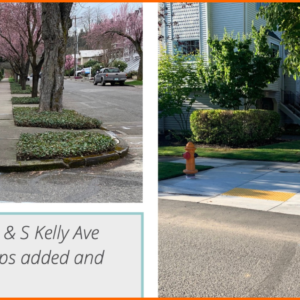
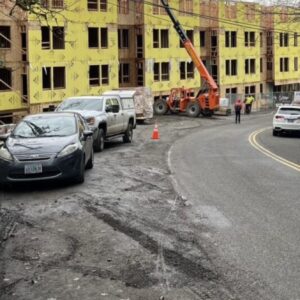
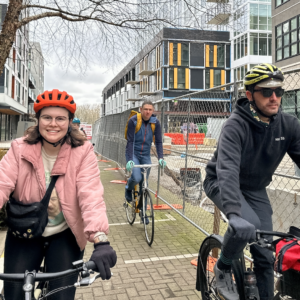

Thanks for reading.
BikePortland has served this community with independent community journalism since 2005. We rely on subscriptions from readers like you to survive. Your financial support is vital in keeping this valuable resource alive and well.
Please subscribe today to strengthen and expand our work.
Way to go Chips Janger and Urban Green (so glad you guys are back in action).
This is exactly the kind of “Clackamas County Creep” we need in Portland to address the parking controversies. Rather than simply reducing parking requirements, we should allow their reduction in exchange for some regreening and bike/ped improvements that that enhance our neighborhoods for people and nature.
Jim
Is Portland blocking density increases or well-off NIMBYs with FYIGM attitudes wanting their neighborhoods to never change?
FYIGM is very accurate.
Might want to look at that map in the linked Tribune article (Outside of E. Moreland and Reed), where do you see the most red?
The new stop here and in downtown Milwaukie will both be a nice walking/biking distance from Elk Rock Island, one of the metro area’s hidden natural gems. If the Orange Line opens on time in September, consider giving it a visit when you take your inaugural Orange Line ride! The river will be low then and the island should be accessible.
Seems like a nice place e to live.
Not really.
McLoughlin Boulvard sucks… I generally stay as far away from it as possible… from Canby to the Columbia River there’s nothing great about 99E… except maybe the view of the falls in Oregon City…
It is a neglected public space. But it has so much potential, the way much of Portland’s inner neighborhoods did until relatively recently. Kudos to Urban Green for recognizing that potential and being creative advocates.
You guys are both quite right.
but BOY do i wish there was a path all the way to Canby!
The bike/pedestrian bridge near Lake Oswego is so badly needed.
The culture shift needed for takeover of Milwaukie by the walking biking crowd is going to require a monumental effort. It’s going to be interesting. Diesel trucks have deep, deep roots in the area right now.
Please let the Elk’s Lodge Property be! We worked so hard to save it over the past two years. We even restored the olympic sized swimming pool! It is an awesome 60,000 sq ft building that provides great assets to that area, far more than some multi story apartment buildings will. There is plenty of OTHER unused space, car lots, all sorts. If you take the heart out of Oak Grove, you’ll have another Division Street.
This is certainly fair, Aly, but one thing I didn’t get into in the article is the fact that the Elks property could be redeveloped at any time with shorter buildings and less natural areas. These people are trying to get their zoning overlay into the county’s books before that happens, so that anyone who might redevelop the lodge would have the incentive to build the tall buildings and also the natural space.
Just adding that extra detail.
Aly,
Thank you for sharing your feelings about the Elks’ site.
Due to the size of the Elks’ lot and it’s proximity to the MAX station, it is and will remain increasingly vulnerable to market forces as time passes. Under the existing zoning ordinance, we have no ability to influence the outcome of redevelopment in any tangible way. Today – by right – a landowner could demolish the Elks’ structures and build anything from a gas station to a strip club to an exact replica of Big Pink – or about 130 market-rate apartments.
We want to modify the zoning ordinance to establish some definition for what can occur on McLoughlin Blvd. and to define requirements and incentives for providing – and preserving – community assets. The Elks’ site has acres of surface parking, for example, that could be redeveloped without even touching the existing building or pool (there are renderings of this concept in the “community vision slideshow” to which Michael linked in the article). If the incentives were right, and the landowner had the flexibility to make the same – or greater – profit by focusing new construction on a smaller portion of the site (e.g., the parking lot, in this case), the existing features of the site that we want preserved could be integrated into the redevelopment plans.
Unfortunately, the existing zoning on McLoughlin provides no such incentive. To take a “do-nothing” approach gambles that redevelopment along McLoughlin will include developers voluntarily “doing the right thing” for the community. Our approach would reward them for doing the right thing.
This is the same Oak Grove that fought off Metro 15-20 years ago to reject increased density and stymie urban development. Either the people living there have changed, or their attitude has. If this type of development occurs, it’d be a great success story for Metro, for New Urban Planning, and for Transit-Oriented Development. It’ll be very interesting to see what happens to this in the coming years.
As the Metro councilor for this part of the region, I can say that Chips, Eleanor, Joseph and a bunch of their neighbors approached me when I first got to Metro more than 7 years ago to tell me about this vision of theirs. They inspire me every day. The same is true of Milwaukie. New leadership in both communities is bringing a smarter perspective and positive energy to our part of the region.
There are still a lot of the same people, but the pitch is for the neighborhood vs an outside force (Metro) coming in and trying to dictate how they develop or live. It’s really all about the eye of the beholder. 🙂
Having talked to people about this project, it’s a pretty exciting effort. I’m really stoked to see it move forward. It’ll benefit everybody in that area AND anybody visiting.
This is the first time I have ever heard of residents in a mostly rural area actually wanting developers to come in and build
I wouldn’t call Oak Grove “rural.” More like an under-burbed suburb.
Rural areas? These still really aren’t rural areas the article is talking about. We’re talking about suburban areas that are wanting a more urban feel with more nature – tree lined streets, walkable options, focus on the natural elements of the area, reduction of massive excessive parking lots (that are empty 98% of the time), etc. This area is by no means rural.
Born and raised and still living in the Oak Grove area- very proud of these folks taking on this task. Yes there will be a huge culture shift-most people in the area like their hidden status-close to portland, but with a rural feel, and dont want to advertise it! But i think alot of people in the area are ready for something positive. the last 15 years has not been kind to the area along McLouglin-there is no where to go or things to ‘do’ along McLoughlin- I know I am tired of driving to OC, Clackamas or Portland. I hope something like this can give some life to the area without taking away its suburban(for lack of a better word) feel.
There are still a lot of the same people, but the pitch is for the neighborhood vs an outside force (Metro) coming in and trying to dictate how they develop or live. It’s really all about the eye of the beholder. 🙂
Having talked to people about this project, it’s a pretty exciting effort. I’m really stoked to see it move forward. It’ll benefit everybody in that area AND anybody visiting.
Unlike many MAX station area developments, this one does not sit adjacent to a freeway (aka Toxic River), so the potential is that much greater. I don’t think it much of a mystery as to why so much development has followed Streetcar, while the record of development along MAX lines is mixed. Who want’s to live next to a freeway where most MAX lines run. I wonder if rents at the new Grant Park “Village” reflect that and at least provide greater affordability.